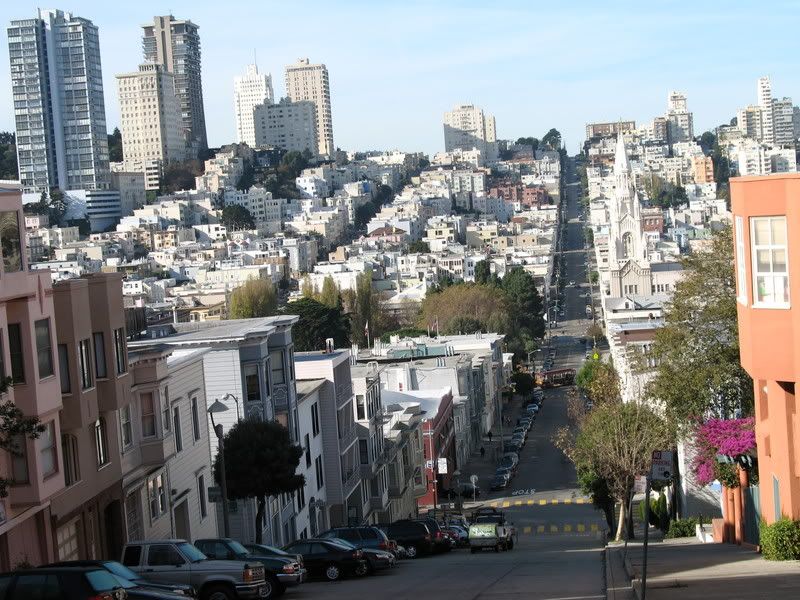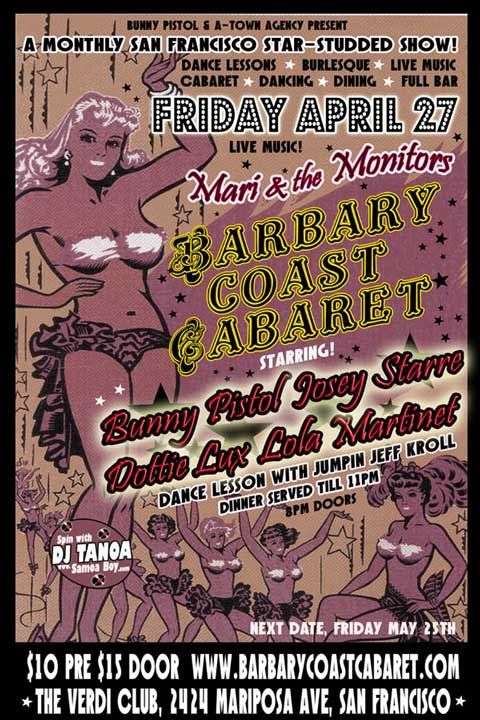The San Francisco Symphony will feature three evenings of music from the Barbary Coast era of the latter half of the 19th century. I think that this is significant in regards to our heritage because--probably more than any other port in North America--San Francisco's Barbary Coast was the gate in which our Cisalpine foremothers and forefathers transgressed, even if they eventually settled in other areas of Northern California or Western Nevada.
A large number settled in North Beach, then part of the Barbary Coast. At that time, that area was on the north coast of the city; and has long since been subject to landfill, which has turned North Beach into an inland district. The name, however, stuck. They were more pioneer than immigrant, because all they did was build, create, and practice self-determination. The Barbary Coast was a wild and dangerous place then. It was like a Deadwood on the coast, or similar to other frontier towns. The historical record is crystal clear that our people has nothing to do with this condition; but were tough enough to handle it and thrive. What I always found interesting is that San Francisco is so far from Genoa, which was the port of departure even if a family was from some other region of the north.
So often, I believe, modern Europeans--reading about the history of European immigration to America--get the impression of great degrees of ethnic bigotry. They don't seem to comprehend that so many of these people were self-determinists who just wanted to practice this self-reliance in a way that they could not in their own country. For example, "who their family was" was not nearly as important as "what they could build and create." Very often, that immigration was totally different than the immigration in modern times.
Barbary Coast and Beyond: Music from the Gold Rush to the Panama-Pacific Exposition
Program
Music from the Gold Rush to the Panama-Pacific Exposition
Program to include works by Bull, Gottschalk, Liszt, Meyerbeer, Offenbach, Wieniawski, Tchaikovsky, Verdi, Sousa, and Saint-Saëns
Sing along with the Orchestra to “California, Here I Come”, “Hello, Frisco, Hello!”, “Hail! California”, and “San Francisco”
Thu, May 10, 2012 8:00pm
Davies Symphony Hall
$35 to $140
Fri, May 11, 2012 8:00pm
Davies Symphony Hall
$35 to $140
Sat, May 12, 2012 8:00pm
Davies Symphony Hall
$35 to $145
More about this Concert
Read the article by James M. Keller, "Music in San Francisco, From the Barbary Coast and Beyond ", about San Francisco's musical history. Read the article online.
Inside Music, an informative talk with James Keller, begins one hour prior to concerts. Free to ticketholders Learn More.
Meet Larry Rothe, author of Music for a City, Music for the World: 100 Years with the San Francisco Symphony, for a book signing in the Symphony Store following the May 12 concert.
Conductor/Performers
Michael Tilson Thomas
conductor
Val Diamond
narrator/actress
Laura Claycomb
soprano
Vadim Gluzman
violin
Anton Nel
piano
Cameron Carpenter
organ
Bill Evans, Jody Stecher, Scott Nygaard
banjo
Caroline McCaskey
musical saw
Jack Van Geem
marimba
United States Air Force Band of the Golden West, Captain Haley Armstrong
commander and conductor
James Robinson
producer and director
J.D. McClatchy
writer
Jeffrey Teeter
video designer
Experience the vibrant musical history of San Francisco in Barbary Coast and Beyond: Music from the Gold Rush to the Panama-Pacific Exposition. MTT and the Orchestra are joined by guest actress and narrator Val Diamond, former star of Beach Blanket Babylon, in a multi-media musical performance celebrating the history of our City and Orchestra from the mid-1800s through the Orchestra’s founding in 1911 and beyond.
In a lively evening of musical heritage visit the rowdy days of the Gold Rush and hear familiar works of the time such as “Oh, Susanna” and “Oh My Darling, Clementine.” Revel in San Francisco’s glorious musical past as organist Cameron Carpenter, soprano Laura Claycomb, violinist Vadim Gluzman, pianist Anton Nel, and the 32-member US Air Force Band of the Golden West perform works brought to San Francisco by virtuosi such as Louis-Moreau Gottschalk and Ole Bull, and opera stars Adah Menken and Luisa Tetrazzini. Popular pieces of the time by Offenbach, Tchaikovsky, Saint-Saëns, and Sousa are represented as well, in an entertaining blend of musical styles. And, sing along with the Orchestra to some of San Francisco’s most memorable tunes such as “California, Here I Come,” “Hello, Frisco, Hello!,” and “San Francisco.”
Patrons with Disabilities
For wheelchair accessible seating, please call Patron Services at (415) 864-6000.
Learn more about our services for patrons with disabilities.
Program Notes
Get in Touch
Box Office: (415) 864-6000
Excerpt from the above featured article 'Music in San Francisco, From the Barbary Coast and Beyond' by James M. Keller:
By 1853, San Francisco could boast ten dedicated theaters. These would soon host many of the great names of the nineteenth-century stage, the likes of Dion Boucicault, Joseph Jefferson, Charles Kean, Edwin Forrest, and Edwin Booth. The city went mad for Shakespeare, and it cultivated a similar passion for opera. The first complete opera given in town was presented at the Adelphi Theatre in February 1851, a performance of La sonnambula by Vincenzo Bellini, whose operas would remain immensely popular in San Francisco along with those of his compatriots Gaetano Donizetti and Giuseppe Verdi. Notable opera stars established themselves here, with partisans lining up behind their favorites of the triumvirate of divas who reigned in the 1850s: the Boston-born Eliza Biscaccianti (a.k.a. “The American Thrush”), the Irish Catherine Hayes (“The Swan of Erin”), and the British Anna Bishop, whom connoisseurs generally considered the finest of the three soprano songbirds, judged on strictly vocal merits.
Excerpt from the program notes from above, entitled 'Barbary Coast and Beyond: Music from the Gold Rush to the Panama-Pacific Exposition' by James M. Keller:
The prospectors arrived with few possessions, but they carried songs with them. Many carried banjos. The five-string banjo tells the story of crossed and blurred barriers of class and race. San Francisco celebrity Lotta Crabtree played banjo for a rough and tumble Gold Rush audience, but opera diva Adelina Patti was also a banjo devotee and gave private recitals for friends. The early banjo was a simple joining of vine, hide, and calabash. Its form and playing technique evolved from African prototypes. By the late nineteenth century, factory production employing skilled artisans produced an instrument that was at once a work of art and a precision tool for playing increasingly complex music, such as the tunes we hear tonight. Philadelphian Paul Eno (1869-1924) was a celebrated composer who conducted several banjo orchestras. Although his composition “A Ragtime Episode” was published in 1903, earlier cylinder recordings suggest it was in circulation before it appeared officially in print. Stephen Foster (1826-64) composed for the parlor and for the minstrel stage. His “Hard Times” (1854) remains current and viable today. Parke Hunter (1876-1912) was a prolific composer and a virtuoso banjoist. His “Pensacola” captures the banjo’s essential qualities.
Polish violinist Henryk (Henri) Wieniawski (1835-80) followed the route to America in 1872. By that time he was one of Europe’s leading virtuosos. He had spent more than a decade in Russia, where pianist-composer Anton Rubinstein had lured him in an effort to improve musical standards in that country. Wieniawski served as solo violinist to the Tsar, was concertmaster for the Russian Musical Society, and taught at the newly established Saint Petersburg Conservatory. He eventually gave in to wanderlust. During his first year in America, he and Rubinstein (his accompanist) gave 215 concerts in sixty cities throughout the eastern states; and the second year (with soprano Pauline Lucca as a guest artist) his calendar extended to 240 performances. The highlight of that second year was his time in California. He documented his time in the state by composing a Souvenir de San Francisco on American song motifs, which was published in 1874. He may have begun his Violin Concerto No. 2 as early as 1856, although it was not premiered until 1862, when he was soloist in Saint Petersburg with his friend Rubinstein conducting. It would have made a hit, and no movement more than the crackling finale, marked à la Zingara—“in Gypsy Style.”
Early San Francisco embraced singers enthusiastically. The Adelphi Theater provided the stage for the first complete opera given in town, in February 1851. The work was La sonnambula by Vincenzo Bellini (1801-35), whose operas would remain immensely popular here, along with those of Gaetano Donizetti (1797-1848) and Giuseppe Verdi (1813-1901). San Francisco became a destination for opera stars of international stature, including the renowned soprano Adelina Patti, who made her local debut in March 1884 as prima donna of Colonel Mapleson’s Opera Troupe. A riot broke out when tickets for her appearances went on sale.
Early San Francisco embraced singers enthusiastically. The Adelphi Theater provided the stage for the first complete opera given in town, in February 1851. The work was La sonnambula by Vincenzo Bellini (1801-35), whose operas would remain immensely popular here, along with those of Gaetano Donizetti (1797-1848) and Giuseppe Verdi (1813-1901). San Francisco became a destination for opera stars of international stature, including the renowned soprano Adelina Patti, who made her local debut in March 1884 as prima donna of Colonel Mapleson’s Opera Troupe. A riot broke out when tickets for her appearances went on sale.
.



No comments:
Post a Comment